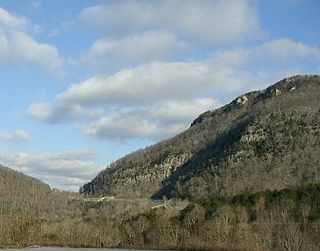
The Cumberland Gap is a pass in the eastern United States through the long ridge of the Cumberland Mountains, within the Appalachian Mountains and near the tripoint of Kentucky, Virginia, and Tennessee. At an elevation of 1,631 feet (497 m) above sea level, it is famous in American colonial history for its role as a key passageway through the lower central Appalachians.

Colonel Allensworth State Historic Park is a state park unit of California, United States, preserving Allensworth, the only California town to be founded, financed and governed by African Americans. The small farming community was founded in 1908 by Lt. Colonel Allen Allensworth, Professor William Payne, William Peck, a minister; John W. Palmer, a miner; and Harry A. Mitchell, a real estate agent, dedicated to improving the economic and social status of African Americans. Colonel Allensworth (1842–1914) had a friendship with Booker T. Washington and was inspired by the Tuskegee Institute and development in its neighboring town. Allensworth hoped to develop the "Tuskegee of the West".
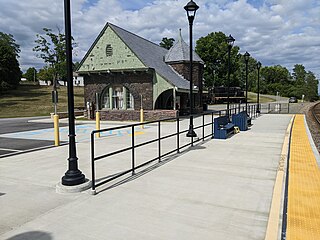
Port Henry station is an Amtrak intercity train station in Port Henry, New York served by the Adirondack. The station has one low-level side platform on the west side of the track.

Allenhurst is an active commuter railroad station in Allenhurst, Monmouth County, New Jersey. Served by New Jersey Transit's North Jersey Coast Line, Allenhurst station operates on the diesel-only segment between Bay Head and Long Branch stations. However, trains also operate to both New York Penn Station and Hoboken Terminal. The next station to the north is Elberon in Long Branch while the next station to the south is Asbury Park. Allenhurst station consists of two low-level side platforms that are not handicapped accessible.

Two Harbors station is a historic train station located on Sixth Street in Two Harbors, Minnesota. The station was built in 1907. The large two-story depot was the third depot on the site. The Minnesota Iron Company developed the Duluth and Iron Range Railroad in 1883, laid out the town of Two Harbors in 1885, and built depots to conducts its business. When the rail line was completed to Duluth, it was used as a transfer point for passengers, lumber, and mining supplies. When passenger service ended in 1961, the depot was donated to Lake County. The building was listed on the National Register of Historic Places in 1983 as the Duluth and Iron Range Railroad Company Depot.

Union Bridge station is a historic railway station in Union Bridge, Carroll County, Maryland. It was built in 1902 as a stop for the Western Maryland Railway. It is representative of the rural railway stations constructed during the late 19th and early 20th centuries. The station's two buildings are arranged with their south façades lengthwise fronting the railroad tracks.

Bridge L-158 is a disused railroad bridge over Muscoot Reservoir near Goldens Bridge, New York, United States. Built to carry New York Central Railroad traffic over Rondout Creek near Kingston, it was moved to its current location in 1904.

The Hinton Historic District is a national historic district located at Hinton, Summers County, West Virginia. The original Hinton Historic District is bordered roughly by the Chesapeake and Ohio Railroad line, James Street, 5th Avenue, and Roundhouse. The boundary increase extended the district to include Mill Street. It was listed on the National Register of Historic Places in 1984 and revised in 2005.
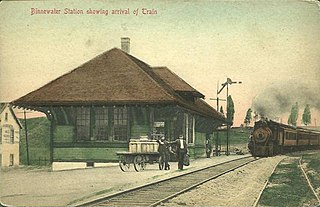
The Binnewater Historic District is a national historic district located at Rosendale in Ulster County, New York, United States. The district originally included nine contributing buildings built during the late 19th and early 20th centuries. They were all frame structures and included a railroad depot, a privy, a general store that was also a post office, a livery stable, two houses, a wagon shed, and two barns. The general store served as an unofficial railroad depot for the Wallkill Valley Railroad from 1875 until 1883, when the railroad constructed the actual station. The station was located too close to Binnewater Road, and was hit repeatedly by trucks. In May 1989, a large piece of the building broke off and fell into the street. The structure was subsequently demolished.

The Delaware, Lackawanna and Western Railroad Water Gap Station is located in Delaware Water Gap, Monroe County, Pennsylvania. Service to Delaware Water Gap along what became known as the Delaware, Lackawanna and Western Railroad started on May 13, 1856. The station structure was designed by architect Frank J. Nies and built in 1903. It consists of two separate one-story brick buildings, a station house and freight house, joined by a common concrete platform and slate covered hipped roof. It is reflective of the Late Victorian style. The station closed to passenger service in March 1953, and was sold to the Borough in 1958. It is said to sit just outside Delaware Water Gap National Recreation Area, though it appears within the area's boundary on maps.
Amenia station is a historic railroad station in Amenia, North Dakota, United States. It was built in 1880, and was designed and/or built by the Northern Pacific Railroad. The depot served Amenia until 1974. It was listed on the National Register of Historic Places in 1977 as the Burlington Northern Depot, and delisted in 2016.

Bristol station is a historic railroad station in Bristol, Virginia, USA, just north of the Tennessee state line. Built in 1902, the station was served by passenger trains until 1971. It was listed on the National Register of Historic Places as Bristol Railroad Station in 1980.

The Wabuska Railroad Station, on S. Carson St. in Carson City, Nevada, was built in 1906. It was a work of the Southern Pacific Co. It was listed on the National Register of Historic Places in 1984.
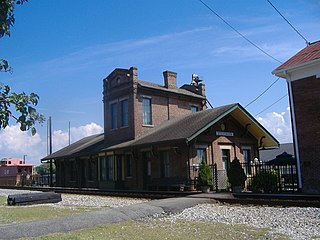
The Stevenson Railroad Depot and Hotel station are a historic train station and hotel in Stevenson, Alabama. They were built circa 1872 as a joint project of the Memphis and Charleston Railroad and the Nashville and Chattanooga Railroad, whose lines converged in Stevenson. When the Memphis & Charleston was purchased by the Southern Railway in 1898, the Louisville and Nashville Railroad took sole control of the depot and operated it until 1976. It was converted into a history museum in 1982. Both buildings are brick with gable roofs and Italianate details. The depot has a central, second-story tower that was added in 1887. The three-story hotel had a lobby, dining room, and kitchen on the first floor and eight large guest rooms on the upper floors. The buildings were listed on the Alabama Register of Landmarks and Heritage in 1975 and the National Register of Historic Places in 1976.

The Tucker Carriage House is a historic carriage house located at Raleigh, North Carolina, United States. It is a large, three-story outbuilding that is the only remaining structure from the estate of Rufus Sylvester Tucker, a Confederate army officer and prominent merchant in post-Civil War Raleigh. It is believed to have been built around 1883, when Tucker purchased materials for a "wagon shed", but does not appear on maps of the area until 1909.
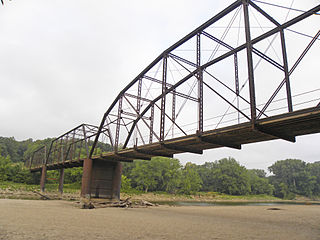
Boone Bridge 2, also known as the Wagon Wheel Bridge, was a historic structure that was located west of Boone, Iowa, United States. It spanned the Des Moines River for 703 feet (214 m). The Boone Commercial Association and the Boone County Board of Supervisors disagreed over the location of a new wagon bridge over the river. The county wanted the new bridge west from Eighth Street in Boone, closer to the Chicago and North Western Railroad's Boone Viaduct. The businessmen wanted to rebuild the Incline Bridge. The dispute was resolved when the Commercial association offered to buy the Incline Bridge. The county contracted with the Iowa Bridge Company to design and build the bridge, which was completed in 1910 for $77,900. The bridge consisted of a long-span Pennsylvania truss over the main channel of the river and three Pratt trusses over the floodplain. It was listed on the National Register of Historic Places in 1998.

Cloverdale station is a bus station and future intermodal station in Cloverdale, California. It is served by Amtrak Thruway and Sonoma County Transit buses. Additional service to Sonoma County Airport station is provided by Sonoma County Transit under contract by Sonoma–Marin Area Rail Transit.
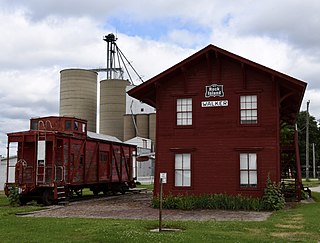
Walker Station is a historic building located in Walker, Iowa, United States. The two-story frame building with bracketed eaves was completed in 1873 along the Burlington, Cedar Rapids, and Minnesota Railway tracks. The depot also served its successor railroads: the Burlington, Cedar Rapids and Northern, and the Chicago, Rock Island and Pacific. Typical of many railroad towns in the Midwest, this is the first building that was built here and the town grew up around it. It is an example of a combination depot that was used for both passenger and freight usage in smaller communities. Because it has a ground level brick platform, service here was primary passenger and light freight service. A higher level of freight service would have required a raised platform.

Split Rock, also known as Twin Peaks, is a mountain in the Granite Mountains of central Wyoming. The peak has an elevation of 7,305 feet (2,227 m), and is located about 10 miles (16 km) north of the Muddy Gap junction between Casper and Rawlins. The mountain is distinctive for a deep V-shaped cleft dividing its summit. The mountain was a prominent landmark on the Oregon Trail and other early settlement routes in the region, which crossed a low rise at the eastern end of the range between Casper and the North Platte River valley and the Sweetwater River.
The Wagon Wheel Gap Hot Springs Resort, near Creede, Colorado, is the historic name of what is now a dude ranch, the 4UR Ranch. It was listed on the National Register of Historic Places in 2019. Of 26 buildings on the property, 14 were deemed to be contributing to the historic character of the listed area, and there were 4 contributing structures and a contributing object.




















